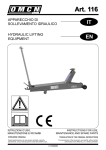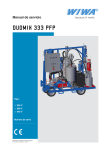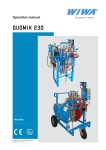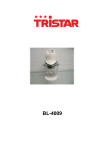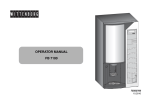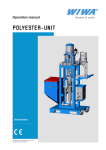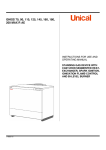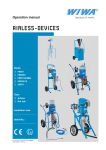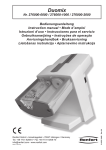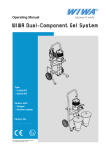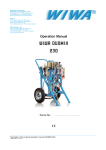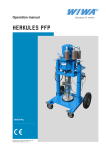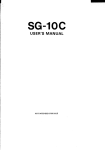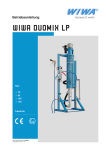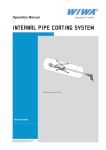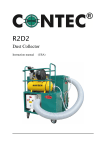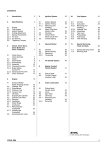Download Operation manual DUOMIX 333 PFP
Transcript
Operation manual DUOMIX 333 PFP Type: 230 V ❍ 400 V ❍ 440 V ❍ Serial-No. ⸏⸏⸏⸏⸏⸏⸏⸏ Translation of the original operation manual PFP_Version 2_DBK_en_1205 · rs Contents Contents 1 Foreword........................................................................................................6 2 Safety..............................................................................................................7 2.1 Explanation of symbols.................................................................................7 2.2 Safety notes..................................................................................................9 2.2.1 Operating pressure.............................................................................9 2.2.2 Risks caused by the spray jet.............................................................9 2.2.3 Hazard from electrostatic charging...................................................10 2.2.4 Hazards from hot or cold surfaces....................................................10 2.2.5 Explosion protection......................................................................... 11 2.2.6 Risks due to the rams....................................................................... 11 2.2.7 Health risks.......................................................................................12 2.3 Information signs on the equipment............................................................13 2.4 Safety features............................................................................................13 2.4.1 Main switch and stop button on control cabinet ...............................13 2.4.2 Safety valves....................................................................................14 2.4.3 Compressed air shut-off valves........................................................14 2.4.4 Safety rupture discs..........................................................................15 2.4.5 Ground cable....................................................................................15 2.4.6 Spray gun lock..................................................................................15 2.4.7 Thermistor-motor protection-trigger..................................................15 2.5 Operating and maintenance personnel.......................................................16 2.5.1 Obligations of the plant owner..........................................................16 2.5.2 Personnel qualification......................................................................16 2.5.3 Authorized operating personnel........................................................16 2.5.4 Personal Protective Equipment........................................................16 2.6 Notes on warranty.......................................................................................17 2.6.1 Conversions and alterations.............................................................17 2.6.2 Accessories and spare parts.............................................................17 2.7 Emergency procedures...............................................................................18 2.7.1 Leakages..........................................................................................18 2.7.2 Injuries..............................................................................................18 2.7.3 Fires..................................................................................................18 3 Unit description...........................................................................................19 3.1 Intended use...............................................................................................19 3.2 Unit configuration........................................................................................20 3.3 System control components.......................................................................22 3.3.1 Control cabinet..................................................................................22 3.3.2 Pressure and dosing control.............................................................23 3.3.3 Control unit for metering pump, flushing pump and pressure vessels.......................................................................23 Translation of the original operation manual DUOMIX 333 PFP3 PFP_Version 2_BAoDB_en_1410 · rs Contents 3.3.4 Ram control......................................................................................24 3.3.5 Regulator cluster for feed pumps......................................................24 3.4 Material feed components..........................................................................25 3.4.1 Flow diagram....................................................................................25 3.4.2 Rams with feed pumps.....................................................................25 3.4.3 Pressure vessels with agitators........................................................26 3.4.4 Metering pump..................................................................................27 3.4.5 Material Flow Heaters.......................................................................27 3.4.6 Intermediate piece............................................................................28 3.4.7 Mixing unit.........................................................................................29 3.5 Flushing unit...............................................................................................30 3.6 Water circulation components.....................................................................30 3.6.1 Flow diagram....................................................................................30 3.6.2 Provision tank...................................................................................31 3.6.3 Circulation pumps.............................................................................31 3.7 Air maintenance unit...................................................................................32 4 Transport, installation and assembly........................................................33 4.1 Transport.....................................................................................................33 4.2 Installation location.....................................................................................34 4.3 Assembly....................................................................................................35 4.3.1 Assembling the hose package..........................................................35 4.3.2 Assembling spray hose and spray gun.............................................36 4.3.3 Grounding the unit............................................................................36 4.3.4 Connecting the compressed air supply.............................................36 4.3.5 Connecting to the electric power supply...........................................37 4.3.6 Opening the ventilation screw on the contact pressure gauge.........37 5 Operation......................................................................................................38 5.1 Taking the system into service....................................................................38 5.1.1 Starting the system...........................................................................39 5.1.2 Put the flushing unit and the water circulation into operation...........39 5.1.3 Flush mixing unit and spray gun.......................................................39 5.1.4 Cleaning the system.........................................................................40 5.1.5 Fill the pressure vessels with material to be applied........................41 5.1.6 Bleed the system..............................................................................42 5.1.7 Adjust the deicing system.................................................................42 5.1.8 Put the material flow heaters into operation.....................................42 5.1.9 Filling the hose package...................................................................43 5.1.10 Checking the mixing ratio...............................................................43 5.2 Coating.......................................................................................................44 5.2.1 Adjusting spraying pressure..............................................................44 5.2.2 Adjusting the pressure and dosing control .......................................44 5.2.3 Tips on coating..................................................................................45 4 Translation of the original operation manual DUOMIX 333 PFP PFP_Version 2_BAoDB_en_1410 · rs Contents 5.2.4 Changing material drums..................................................................45 5.3 Flushing......................................................................................................46 5.4 Cleaning the static mixer............................................................................46 5.5 Work breaks................................................................................................47 5.5.1 Short interruption of work..................................................................47 5.5.2 Longer work break............................................................................47 5.6 Placing the system out of operation............................................................47 5.7 Storage.......................................................................................................48 5.8 Waste disposal............................................................................................48 6 Maintenance.................................................................................................49 6.1 Regular inspections....................................................................................49 6.2 Maintenance plan.......................................................................................50 6.3 Air maintenance unit...................................................................................50 6.3.1 Checking the lubricant level in the fog oiler......................................50 6.3.2 Checking and adjusting the fog oiler.................................................50 6.3.3 Checking and cleaning the water separator.....................................51 6.4 Metering pump............................................................................................51 6.4.1 Checking release agent for material residues..................................51 6.5 Feed pumps................................................................................................51 6.5.1 Checking the release agent level in the feed pumps........................51 6.5.2 Readjust the upper packing of the feed pumps................................52 6.5.3 Changing the upper packing of the feed pumps...............................52 6.5.4 Replacing the seals on the follow plate............................................52 6.6 Recommended operating materials............................................................53 6.7 Special tools...............................................................................................53 7 Rectification of faults..................................................................................54 8 Technical data..............................................................................................57 8.1 Machine card..............................................................................................57 8.2 Type plates..................................................................................................57 Translation of the original operation manual DUOMIX 333 PFP5 PFP_Version 2_BAoDB_en_1410 · rs Foreword 1 Foreword Dear Customer! We are delighted that you have decided in favour of a DUOMIX 333 PFP from our company. This operating manual is intended for the operating and maintenance personnel. It contains all the information required to working with this unit. The owner of the unit must ensure that the operator of the unit always has an operating manual at his/her disposal in a language he/she understands! Safe and reliable operation of the system requires further information in addition to this operating manual. ➤➤ Read and comply with the applicable guidelines for your country. In Germany, these are the “Richtlinien für Flüssigkeitsstrahler” (Guidelines for Liquid Jets), issued by: the Hauptverband der Gewerblichen Berufsgenossenschaften. ➤➤ Moreover the manufacturer’s instructions and guidelines for coating or feeder materials are to be respected at all times. We strongly recommend to add all relevant guidelines and accident prevention instructions to this operating manual. However, if you have any questions, please do not hesitate to contact us. Excellent work results with your WIWA DUOMIX 333 PFP wishes WIWA Wilhelm Wagner GmbH & Co. KG. Copyright © 2014 WIWA The copyright for this operating manual lies with WIWA Wilhelm Wagner GmbH & Co. KG Gewerbestraße 1-3 • 35633 Lahnau • Germany Phone: +49 6441 609-0 • Fax.: +49 6441 609-50 • E-mail: [email protected] • Internet: www.wiwa.de This operating manual is solely intended for personnel involved in preparation, operation and servicing. It is prohibited to pass on this operating manual for reproduction, utilisation or communication of its contents, unless this has been explicitly permitted. Infringements incur an obligation to pay damage compensation. All rights reserved in the event of registration of the patented design, industrial design or registered design. 6 Translation of the original operation manual DUOMIX 333 PFP PFP_Version 2_BAoDB_en_1410 · rs Safety 2 Safety This unit has been designed and manufactured while taking into consideration all safety-related aspects. It corresponds to the current standard of technology and to applicable accident prevention regulations. The unit left the factory in perfect condition and guarantees a high level of technical reliability and safety. Nevertheless, there are certain risks that can arise from incorrect operation or misuse: ➤➤ to life and limb of the operator or third party, ➤➤ to the machine and other material assets of the owner, ➤➤ to the efficient working capacity of the unit. In principle you should refrain from any work method that could affect the safety of operating personnel and equipment. All persons involved in set-up, commissioning, operation, maintenance, repair and servicing of the unit must have read and understood the operating manual beforehand, especially the chapter “Safety”. Your safety is at stake! We recommend to the owner of this unit to have this confirmed in writing. 2.1 Explanation of symbols Safety notes warn of potential accident hazards and identify the necessary measures to prevent accidents. In the operating manuals from WIWA safety notes are particularly highlighted and marked as follows: DANGER Highlights accident hazards which if disregarding the safety note will result most likely in severe or even fatal injuries! WARNING Highlights accident hazards which if disregarding the safety note can result in severe or even fatal injuries! CAUTION Highlights accident hazards which if disregarding the safety note can result in injuries! Highlights important information for the proper use of the equipment. Disregarding this information can result in damage to the equipment or to the environment. Depending on the hazard source different pictograms are used in safety notes about accident hazards with risk of injury – examples: General accident hazard Risk of explosion from explosive atmospheres Translation of the original operation manual DUOMIX 333 PFP7 PFP_Version 2_BAoDB_en_1410 · rs Safety Risk of explosion from explosive substances Accident hazard from voltage or static electricity Risk of crushing by moving unit parts Risk of burns from hot surfaces Risk of frostbite from cold surfaces Security orders primarily indicated to wear protective equipment. They are also highlighted and marked as follows: Wear protective clothing Highlights the order to wear the prescribed protective clothing to protect against skin injuries caused by spraying material or gases. Use eye protection Highlights the order to use eye protection in order to prevent your eyesigh from being damaged by material splatter, gases, vapors or dust. Wear ear defenders Highlights the order to use ear defenders in order to prevent your sense of hearing from being damaged by noise. Use a respiratory protection mask Highlights the order to use a respiratory protection mask in order to prevent your respiratory tract from being damaged by gases, fumes or dusts. Wear protective gloves Highlights the order to wear protective gloves with lower arm protection to protect against burn injuries caused by heated materials. Wear protective footwear Highlights the order to wear protective footwear to prevent injuries to the feet due to tumbling, falling or rolling objects, and a slip on slippery surfaces. Reading is an absolute must Highlights references to guidelines, work and operating manuals, which must be strictly followed. 8 Translation of the original operation manual DUOMIX 333 PFP PFP_Version 2_BAoDB_en_1410 · rs Safety 2.2 Safety notes Please remember that the DUOMIX 333 PFP works with extremely high pressures and may cause life threatening injuries if used inappropriately! Always observe and follow the information in this operating manual as well as in the separate operating manuals for individual system components or the optionally available accessories. The accident prevention instructions „Application of Coating Materials“ (BGR 500, chapt. 2.25) and the guidelines for liquid jets ZH1/406 of the employer‘s liability insurance association must strictly be complied with. 2.2.1 Operating pressure WARNING Components that do not comply with the maximum permissible operating pressure may burst und cause severe injuries. ➤➤ The specified maximum operating pressures must generally be complied with for all components. In case of varying operating pressures the lowest value is always valid as the maximum admissible operating pressure for the entire system. ➤➤ Material hoses and hose assemblies must comply with the maximum working pressure, including the required safety factor. ➤➤ Material hoses must be leak tight and free of kinks, signs of abrasion or bulges. ➤➤ Hose connections must be tight. 2.2.2 Risks caused by the spray jet WARNING The material is discharged from the spray gun under very high pressure. Due to its cutting effect the spray jet can cause severe injuries by penetrating the skin or entering into the eyes. ➤➤ Never point the spray gun at yourself, other persons or animals! ➤➤ Do not hold your fingers or hands in front of the spray gun! ➤➤ Do not reach with your hands into the spray jet! WARNING Unintentional material release from the spray gun may cause personal injury or damage to property. ➤➤ Always secure the spray gun, even for shortest work breaks! ➤➤ Always make sure that the spray gun is properly secured before each use! Translation of the original operation manual DUOMIX 333 PFP9 PFP_Version 2_BAoDB_en_1410 · rs Safety 2.2.3 Hazard from electrostatic charging WARNING The high flow velocities associated with the Airless spraying method may cause static charging. Static discharges can cause fire and explosion. ➤➤ Ensure that the unit has been properly grounded outside of explosive atmosphere areas! ➤➤ Also ground the object to be coated. ➤➤ Always use open containers! ➤➤ Never spray solvents or materials containing solvent into cone-top cans or drums with a bunghole! ➤➤ Place the containers on a grounded surface. ➤➤ Always use electrically conductive containers. ➤➤ Achten Sie stets auf Kontakt der Spritzpistole mit der Behälterwand. ➤➤ Watch out for contact between spray gun and container wall. ➤➤ Only use conductive material hoses. All original material hoses from WIWA are conductive and perfectly adapted to our equipment. WARNING If the unit is contaminated by material during operation, the increased coating thickness can lead to electrostatic charging. Static discharges can cause fire and explosion. ➤➤ Clean the unit immediately to remove any contamination. ➤➤ Carry out cleaning work outside areas with explosive atmospheres. 2.2.4 Hazards from hot or cold surfaces CAUTION The use of material heaters can cause the surfaces of the unit to become hot. Risk of burns. ➤➤ Always wear protective gloves with lower arm protection (gauntlet) when working with heated materials! CAUTION The air motors become very cold during operation. There is a high risk of local frostbite. ➤➤ The air motors should warm up to a temperature above 10 °C before starting any work on the unit. ➤➤ Always wear suitable protective gloves! 10 Translation of the original operation manual DUOMIX 333 PFP PFP_Version 2_BAoDB_en_1410 · rs Safety 2.2.5 Explosion protection WARNING Equipment designed without explosion protection must not be used in workshops that come under the explosion protection ordinance! Explosion protected systems fulfil the explosion protection requirements of the Directive 94/9/EC for the explosion group, unit category and temperature class specified on the type plate or in the declaration of conformity. The operator is responsible for determining the zone allocation according to the Directive of EC 94/9/EC, Appendix II, no. 2.1-2.3 when observing the measures of the responsible inspecting authority. The operator is responsible for checking and ensuring that all technical data and markings according to ATEX correspond with the necessary requirements. Please note that several components have their own type plate with separate marking according to ATEX. In this case the lowest explosion protection of all attached markings applies for the entire system. Applications where the malfunction of the unit can lead to danger to personnel must be provided with respective safety measures by the operator. However, if agitators, heaters or other electrically accessories are additionally mounted, one must check the explosion protection. Plugs for heaters, agitators, etc. that do not have explosion protection, may only be plugged in outside of areas that fall under the explosion protection ordinance, even if the accessory equipment as such is explosion protected. 2.2.6 Risks due to the rams WARNING While the rams are lifting, the moving components can crush your fingers, hands or other parts of the body. ➤➤ Do not reach in between the follow plate and the material container, the traverse and the cover of the pneumatic cylinder or the clamping piece and and the cover of the pneumatic cylinder. WARNING While the rams are lifting, loose clothing can get between the follow plate or the follow cover and the material drum or catch on other machine parts or be pulled upwards. ➤➤ Wear tight-fitting working clothes that are not very tear-resistant, that have tight-fitting sleeves and no protruding parts. WARNING While the rams are lifting, the moving components can cause crushing and impact injuries. ➤➤ Persons should not remain in the stroke area of the rams while the rams are lifting! Translation of the original operation manual DUOMIX 333 PFP11 PFP_Version 2_BAoDB_en_1410 · rs Safety WARNING Accidental starting of the rams can result in crushing and impact injuries. ➤➤ At every interruption whether intentional or due to a disturbance, always set the control lever to the “Stop” position. WARNING Objects placed on the rams may fall down during a stroke movement and cause injuries. ➤➤ Never place any objects on the rams! 2.2.7 Health risks Follow the safety notes and dosing information of the manufacturer and the generally applicable regulations when handling paints, solvents, oils, greases and other chemical substances. Rests of paints, solvents, oils, greases and other chemical substances must be collected in accordance with statutory provisions concerning recycling and waste disposal. The official local waste water laws are valid. CAUTION Depending on the materials being applied solvent vapours may be generated which could cause damage to health and objects. ➤➤ Always ensure sufficient aeration and ventilation at the workplace. ➤➤ Always observe the processing instructions issued by the material manufacturers. CAUTION Solvents or other harmful substances are not suitable to clean your skin and can result damage to health. ➤➤ Use only appropriate skin protection, skin cleaning and skin care products. In closed or pressurized systems dangerous chemical reactions may occur if parts made of aluminium or galvanized parts come into contact with 1.1.1 trichloroethane, methylene chloride or other solvents containing halogenated hydrocarbons (CFC’s). If you want to process materials containing the afore mentioned substances, we recommend to consult the material manufacturer to clarify the usability of such substances. For these materials we have a range of rust and acid proof versions available. 12 Translation of the original operation manual DUOMIX 333 PFP PFP_Version 2_BAoDB_en_1410 · rs Safety 2.3 Information signs on the equipment Information signs attached to the equipment, such as safety information (see Fig. 1) refer to possible danger areas and must be strictly followed. They must not be removed from the equipment. Damaged and illegible information signs must be replaced immediately. Apart from this you should also read and follow the safety notes in the operating manual. Fig. 1: Safety Information 2.4 Safety features Safety features must be checked with the system depressurized: ➤➤ before initial commissioning, ➤➤ always before starting work, ➤➤ after completion of setup work, ➤➤ after cleaning, maintenance and repair work! Check list: 55 Main switch and stop button on control cabinet moveable? 55 Lead seal on the safety valve still intact? 55 Safety valves externally free of damage? 55 Function of compressed air shut-off valve correct? 55 Correct functioning of safety levers on spray gun? WARNING If one of the safety features is missing or not fully functional, the operating safety of the system cannot be guaranteed! ➤➤ If you discover any faults on the safety features or other deficiencies on the system, stop operation of the system immediately. ➤➤ Only resume operation of the system after the fault has been completely rectified. 2.4.1 Main switch and stop button on control cabinet The electric system of the device can be switched on and off with the main switch on the control cabinet (see chapter 3.3.1 on page 22) . The stop button allows you to interrupt the compressed air supply for the metering pump and thus shut it down. Translation of the original operation manual DUOMIX 333 PFP13 PFP_Version 2_BAoDB_en_1410 · rs Safety 2.4.2 Safety valves The DUOMIX 333 PFP is equipped with safety valves: ➤➤ in the air intake of the air maintenance unit to the metering pump (see Fig. 2), ➤➤ in the air motors of the feed pumps and the flushing pump, ➤➤ in the pressure vessels for both components. The safety valves ensure that the max. permissible air inlet pressure is not exceeded. If the air inlet pressure exceeds the fixed limiting value at one of the points mentioned above, the corresponding safety valve will blow off. Fig. 2: Safety valve WARNING If the maximum permissible air inlet pressure is exceeded, components may burst. This may result in damage to persons and property. ➤➤ Never allow the system to run without or with defective safety valves! ➤➤ If a safety valve needs to be replaced, you can find the corresponding order number on the machine card. ➤➤ When using new safety valves make sure that the valves have been set to the max. permissible air inlet pressure of the DUOMIX 333 PFP as required for the mixing ratio (see type plate or machine card) and sealed with a lead seal. Changing the mixing ratio may cause a change in pressure ratio and thus require the adaptation of the max. permissible air inlet pressure of the metering pump. In this case you would have to replace the safety valve of the metering pump and the type plate – you should absolutely contact WIWA. 2.4.3 Compressed air shut-off valves The compressed air shut-off valve on the air maintenance unit interrupts the air supply for the entire system. Open Closed Fig. 3: Compressed air shut-off valve opened Fig. 4: Compressed air shut-off valve closed Furthermore, the system is equipped with further compressed air shut-off valves for interrupting the air supply to individual system components, like e.g. to feed pumps or pressure vessels. 14 Translation of the original operation manual DUOMIX 333 PFP PFP_Version 2_BAoDB_en_1410 · rs Safety The functional principle of all pressure and material shut-off valves is identical: ➤➤ Set in flow direction to open, ➤➤ Set across the flow direction to close. Once the air supply is cut off, the system is still under pressure. Before starting work on the system you must therefore relieve the pressure completely. 2.4.4 Safety rupture discs The safety rupture discs make sure that the permissible operating pressure is not considerably exceeded. They are located in the screw fitting behind the intermediate piece. If a safety rupture disc is damaged material will escape from the hose of the safety rupture disc safety device.. In this case the safety rupture disc must be replaced immediately. Fig. 5: Safety rupture disc seat You find the corresponding ordering data on the machine card A new safety rupture disc must be installed with the coloured side facing towards the pressure. 2.4.5 Ground cable The ground cable is used to prevent electrostatic charging of the unit. The ground cable is already connected to the cart of the unit when it is delivered. In order to ground the unit, connect the clamp of the ground cable to an electrically conductive object outside explosive atmosphere areas. Fig. 6: Ground cable Replace the ground cable immediately if lost or damaged! 2.4.6 Spray gun lock The spray gun must always be secured against unintended operation, even for the shortest of work breaks. Set the safety lever horizontally to secure the spray gun. Fig. 7: Spray gun lock 2.4.7 Thermistor-motor protection-trigger This relay serves to monitor temperature in the agitators’ motors When overheating occurs, the agitator will shut down and a fault will be signalised at the control cabinet. Translation of the original operation manual DUOMIX 333 PFP15 PFP_Version 2_BAoDB_en_1410 · rs Safety 2.5 Operating and maintenance personnel 2.5.1 Obligations of the plant owner The owner of the plant: ➤➤ is responsible for training the operating and maintenance personnel, ➤➤ must direct the operating and maintenance personnel to handle the plant appropriately and to wear correct work clothes and protective equipment, ➤➤ must make the user manual accessible to the operating and maintenance personnel and ensure that it remains available at all times, ➤➤ must ensure that the operating and maintenance personnel have read and understood the user manual. Only then the system may be taken into service. 2.5.2 Personnel qualification A differentiation is made between two groups of people in dependence on their qualifications: ➤➤ Instructed operators have been verifiably instructed by the plant owner in the activities they are tasked with and the potential risks connected with them in the case of incorrect behaviour. ➤➤ Trained personnel have been instructed by the plant manufacturer such that they are capable of carrying out maintenance and repair work on the system and recognising potential risks on their own initiative and of avoiding these risks. 2.5.3 Authorized operating personnel Activity Qualification Setup and operation Instructed operators Cleaning Instructed operators Servicing Trained personnel Repair Trained personnel Juveniles under the age of 16 have no permission to operate this equipment. 2.5.4 Personal Protective Equipment Wear protective clothing Always wear the protective clothing prescribed for your work environment (mining, closed rooms, etc.) and follow the recommendations in the safety data sheet issued by the material manufacturer. Use eye protection Wear protective goggles to protect against eye injuries caused by material splatter, gases, vapors or dust. 16 Translation of the original operation manual DUOMIX 333 PFP PFP_Version 2_BAoDB_en_1410 · rs Safety Wear ear defenders Operating personnel should be provided with suitable noise protection equipment. The operator is responsible for adhering to the accident prevention regulation “Noise” (BGV B3). For this purpose, pay special attention to the conditions of the installation location – the noise burden will increase if the system is installed in or on hollow bodies. Use a respiratory protection mask We strongly recommend to wear a respiratory protection mask, even though the paint mist has been minimized in Airless spray painting applications with correct pressure setting and working mode. Wear protective gloves When applying heated materials you should wear protective gloves with lower arm protection to prevent burns. Wear protective footwear Wear protective footwear to prevent injuries to the feet due to tumbling, falling or rolling objects, and a slip on slippery surfaces. 2.6 Notes on warranty 2.6.1 Conversions and alterations ➤➤ Unauthorized conversions or alterations should not be undertaken on safety grounds. ➤➤ Protective equipment should not be dismantled, converted or bypassed. ➤➤ Use of components which have not been manufactured or delivered by WIWA renders any warranty null and void. ➤➤ The unit should only be operated within the prescriptive limit values and machine parameters. 2.6.2 Accessories and spare parts ➤➤ If you use original accessories and spare parts from WIWA, their suitability for use with our equipment is guaranteed. ➤➤ It is, however, mandatory to respect the safety regulations of the accessories and spare parts. You will find these safety regulations in the corresponding operating manuals for the accessories and spare parts. ➤➤ If foreign accessories or spare parts are used, the company WIWA cannot guarantee the safety of the entire system. Liability for damages or injuries incurred because of the use of those accessories and spare parts becomes null and void. Translation of the original operation manual DUOMIX 333 PFP17 PFP_Version 2_BAoDB_en_1410 · rs Safety 2.7 Emergency procedures 2.7.1 Leakages WARNING In case of leakages material can escape under very high pressure and cause serious bodily injuries and material damage. ➤➤ Shut down and depressurize the system immediately. ➤➤ Switch off the electric power supply by the master switch on the control cabinet. ➤➤ Re-tighten the connections and replace defective components (only by trained personnel). ➤➤ Do not seal leakages on connections and high pressure hoses by hand or by wrapping fabric around them. ➤➤ Do not repair material hoses! ➤➤ Check hoses and connections for leaks before restarting. 2.7.2 Injuries In case of injuries you should immediately consult a physician or visit the nearest hospital. If injured by processing materials or solvents always have the safety data sheet (address, phone number, material designation and material number of supplier or manufacturer) available for the attending physician. ➤➤ Always remember where you can call for help. ➤➤ Keep a list of the local emergency telephone numbers at hand. ➤➤ You should in any case make yourself familiar with First-Aid measures. 2.7.3 Fires ➤➤ Read and comply with the instructions for fire alarm and escape routes, which are displayed in your factory or at any work place. ➤➤ Keep a list of the local emergency telephone numbers at hand. ➤➤ Become acquainted with the locations and operation of fire alarms and fire extinguishers within your reach. ➤➤ Ensure a sufficient amount of information signs for the avoidance of fire. ➤➤ Only use the extinguishing substances stipulated by the material manufacturer. 18 Translation of the original operation manual DUOMIX 333 PFP PFP_Version 2_BAoDB_en_1410 · rs Unit description 3 Unit description The WIWA DUOMIX 333 PFP is a dual-component coating system for insulating layer forming flame retardants in commercial and industrial applications. The system was designed to meet special customer requirements (material to be applied, mixing ratio, transfer quantity, etc.). Exact metering of both components is assured by the fixed mixing ratio. The mixing ratio can be changed by exchanging the fluid pumps. The WIWA DUOMIX 333 PFP is used for coating steel parts in structural engineering, as weil as in the oil and gas industry. Please refer to the enclosed machine card (technical data) for the machine specifications of your machine. 3.1 Intended use The WIWA DUOMIX 333 PFP is intended for the application of insulating layer forming flame retardants in commercial and industrial applications. Any other use is considered unintended. Should you intend to use the system for other purposes or with other materials and thus not for the purpose it is intended for, you must ask WIWA for permission – otherwise warranty will become null and void. Intended use also includes compliance with the technical documentation and adherence to the prescribed operating, servicing and maintenance guidelines. Translation of the original operation manual DUOMIX 333 PFP19 PFP_Version 2_BAoDB_en_1410 · rs Unit description 3.2 Unit configuration 6 8 1 2 9 10 11 3 4 5 7 Fig. 8: Front view of the DUOMIX 333 PFP No. Designation 1 Control cabinet 3 Contact pressure gauge of pressure and dosing control 5 Material Flow Heaters 2 4 6 7 8 9 10 11 20 Control unit for metering pump, flushing pump and pressure vessels Intermediate piece to connect the hose package Agitators Fork lift pick-up points Regulator cluster for feed pumps Flushing pump Pressure vessel for B component (capacity depending on unit configuration 45 l or 60 l) Water circulation provision tank (capacity 30 l) Translation of the original operation manual DUOMIX 333 PFP PFP_Version 2_BAoDB_en_1410 · rs Unit description 18 12 21 13 14 15 16 17 19 Fig. 9: Rear view of the DUOMIX 333 PFP 20 No. Designation 12 Feed pump for A-component 14 Ram for B-component 13 15 16 17 Feed pump for B-component Ram control Ram for A-component Cleaning agent tank (capacity 50 l) 18 Maintenance unit 20 Water circulation pump 19 21 Pressure vessel for A component (capacity 60 l) Metering pump Translation of the original operation manual DUOMIX 333 PFP21 PFP_Version 2_BAoDB_en_1410 · rs Unit description 3.3 System control components 3.3.1 Control cabinet 1 2 3 4 Paintheating Watercirculation Agiator Comp A Agiator Comp B auto 0 manual auto 0 manual auto 0 manual Off On 5 error fuse 6 Start Stop 7 8 9 manual / auto 10 Fig. 10: Control cabinet No. Designation 1 2 3 On/Off switch material flow heaters Three-position switch for water circulation and water heating (circulation pump and heaters for circulation water and cleaning agent) Three-position switch for the agitator of component A 4 Three-position switch for the agitator of component B 6 Timer to set the operating time for automatic operation 5 7 8 9 10 Signal lamp for fault messages Start button for pressure and dosing control (see chapter 3.3.2) Stop button of pressure and dosing control Selector switch “Manual/Automatic” of pressure and dosing control Main switch to switch the system electrics on and off. The three-position switches (no. 2, 3 and 4) have 3 positions: ➤➤ In position “auto” the corresponding system component is automatically switched on and off, in accordance with the operating times set by the timer. ➤➤ In position “0” the corresponding system component is switched off – the operating times set on the timer are of no relevance. ➤➤ In position “manual” the corresponding system component is switched on – also in this case the operating times set on the timer are of no relevance. 22 Translation of the original operation manual DUOMIX 333 PFP PFP_Version 2_BAoDB_en_1410 · rs Unit description 3.3.2 Pressure and dosing control The 3 buttons on the control cabinet below the timer and the contact pressure gauge belong to the pressure and dosing control. 4 1 2 3 Start Stop manual / auto Fig. 12: Buttons on the control cabinet Fig. 11: Contact pressure gauge No. Designation 1 The “Start” button is used to restart the system after a shutdown. Regulate the air inlet pressure of the metering pump completely back beforehand! 2 The “Stop” button is used to shutdown the system manually. 3 With the selector switch “Manual/Automatic” you decide whether both operation limits should be monitored (= “Automatic”), or only the upper one (= “Manual”). For start-up, set the selector switch to “Manual”. For spray operation, set the selector switch to “Automatic”. 4 The contact pressure gauge monitors the pressure of the B-component (hardener) and switches the system off when the operation limits are reached. 3.3.3 Control unit for metering pump, flushing pump and pressure vessels 7 1 2 8 9 10 11 3 4 5 6 No. Designation 1 Pressure gauge metering pump 2 Pressure gauge flushing pump 4 Air pressure regulator pressure vessel A 3 5 6 7 Pressure gauge pressure vessel A Pressure gauge pressure vessel B Air pressure regulator pressure vessel B Air pressure regulator metering pump 8 Air pressure regulator flushing pump 10 Temperature indicator for A component, with Fahrenheit and Celsius scales 9 11 Temperature indicator for water circulation, with Fahrenheit and Celsius scales Temperature indicator for B component, with Fahrenheit and Celsius scales Fig. 13: Control unit for metering pump, flushing pump and pressure vessel Translation of the original operation manual DUOMIX 333 PFP23 PFP_Version 2_BAoDB_en_1410 · rs Unit description The functional principle of all air pressure regulators is identical: ➤➤ Turn clockwise to increase the pressure, ➤➤ turn anti-clockwise to reduce the pressure. 3.3.4 Ram control 1 5 2 6 Up Stop 3 4 Down Fig. 14: Ram control No. Designation 1 Air pressure regulator for the B-component ram 3 Control lever for the B-component ram 2 4 5 6 Pressure gauge for the B-component ram Control lever for the A-component ram Air pressure regulator for the A-component ram Pressure gauge for the A-component ram The control Ievers (no. 3 and 4) are used to move the rams up and down or stop it when placing or changing the material containers. 3.3.5 Regulator cluster for feed pumps 1 3 4 2 5 Fig. 15: Regulator cluster for feed pumps 6 No. Designation 1 Air pressure regulator for the B-component feed pump 3 B-component shut-off valve 2 24 Air pressure regulator for the A-component feed pump Translation of the original operation manual DUOMIX 333 PFP PFP_Version 2_BAoDB_en_1410 · rs Unit description No. Designation 4 Pressure gauge for the B-component feed pump 6 A-component shut-off valve 5 Pressure gauge for the A-component feed pump The two shut-off valves are controlled by the level monitoring in the pressure vessels. Once the minimum quality is reached in one of the pressure vessels, the shut-off valve for this component is automatically opened. The corresponding feed pump then keeps delivering material into the pressure vessel, until the maximum level is reached. The shut-off valve is then automatically closed again and the feed pump switched off. 3.4 Material feed components 3.4.1 Flow diagram Rams with feed pumps Pressure vessels Main pump Material flow heater Intermediate piece Mixing unit Spray gun Return flow 3.4.2 Rams with feed pumps The two rams support the feed pumps in the transfer of material to be processed. You can place the material drums here once you have run up the rams. The feed pumps deliver the material to be applied from the drums into the pressure vessels. No. Designation 1 2 3 4 Compressed air shut-off valve of feed pump 2 4 3 Feed Pump Ram 5 Ball valve for the container ventilation Breather valve 7 Follower plate 6 1 5 6 Ventilation ball valve 7 Fig. 16: Ram with feed pump Translation of the original operation manual DUOMIX 333 PFP25 PFP_Version 2_BAoDB_en_1410 · rs Unit description 3.4.3 Pressure vessels with agitators 2 3 4 5 6 1 No. Designation 1 Agitator 3 Compressed air connection with stop cock 2 Pressure relief valve with stop cock 4 Safety valve (6 bar) 5 Fig. 17: Pressure vessels Safety valve (8 bar) 6 Inspection hole with cover CAUTION Open the inspection hole only after all pressure has been relieved from the pressure vessel! The pressure vessels are double-walled – circulation water flows through the area between the outer and the inner container, the inner container is used to store and treat the material to be applied. In units that are equipped with only one circulation pump (see chap. 3.6.3 on page 31), a thermostatic valve is installed at the inlet of the hot water circulation into the A-component pressure vessel, which can be used to adjust the temperature of the circulation water in the two pressure vessels. Observe and follow the notes in the separate operating manual of the thermostatic valve. Fig. 18: Thermostatic valve The agitators installed in the pressure vessels ensure uniform heating and consistency of the material by drawing it from the wall into the middle of the container, rather than stirring it up from the bottom. They are switched on and off on the control cabinet (see chapter 3.3.1 on page 22). Observe and follow the notes in the separate operating manuals for pressure vessels and the agitators. 26 Translation of the original operation manual DUOMIX 333 PFP PFP_Version 2_BAoDB_en_1410 · rs Unit description 3.4.4 Metering pump No. Designation 1 Silencer 3 Fluid pumps for A component 2 4 4 1 Air motor with deicing system Fluid pump for B component Material shut-off valves The metering pump delivers the material to be applied from the pressure vessels through the material flow heaters to the intermediate piece and from there, depending on the position of the return flow ball valve, through the mixing unit to the spray gun, or back into the pressure vessel. The air motor drives usually 3 fluid pumps – two for A component and one for B component. The mixing ratio results from the ratio of pump sizes. Units with mixing ratio 1 : 1 are equipped with two equal-sized fluid pumps – the middle pump (No. 4) is omitted. Depending on the material requirements, the mixing ratio can be adjusted by exchanging the fluid pumps. All you need are the proper tools and the appropriate fluid pumps. 2 3 3 4 5 Fig. 19: Metering pump The deicing system on the air motor reduces icing of the air motor during operation. The deicing adjusting screw is located on the air outlet of the air maintenance unit for the metering pump (see chapter 3.7 on page 32). 3.4.5 Material Flow Heaters On its way from the metering pump to the intermediate piece the material to be applied is depending on unit configuration guided through 3 or 4 material flow heaters, where it is heated up. Pressure gauges The material flow heaters are switched on and off on the control cabinet. The temperature regulators are directly located on the material flow heaters. Temperature control Fig. 20: Material Flow Heaters You can read the material temperature of both components on the regulator cluster for metering pump, flushing pump and pressure vessels. Pressure gauges are installed at the inlet of the material flow heaters, where you can read the material pressure of the A and B component. Translation of the original operation manual DUOMIX 333 PFP27 PFP_Version 2_BAoDB_en_1410 · rs Unit description Observe and follow the notes in the separate operating manual of the material flow heaters. 3.4.6 Intermediate piece The intermediate piece serves the purpose of connecting the hose package (see chapter 4.3.1). Furthermore, there are the levers to open and close the circulation an the material outlets to the hose package as well as the shut-off valves for the hose heating. 4 1 2 5 3 Fig. 21: Levers for circulation and material outlets Fig. 22: Shut-off valves for the hose heating No. Function 1 Opening and closing the circulation (return flow to pressure vessels) 2 Opening and closing the material outlet of A component 4 Opening and closing the return flow of hose heating 3 5 Opening and closing the material outlet of B component Opening and closing the flow of hose heating Fig. 24: Circulation closed, material outlets open 28 Fig. 23: Circulation open, material outlets closed Translation of the original operation manual DUOMIX 333 PFP PFP_Version 2_BAoDB_en_1410 · rs Unit description Set the shut-off valves for the hose heating in flow direction to open (as shown in Fig. 22). Set the shut-off valves for the hose heating across the flow direction to close. 3.4.7 Mixing unit The mixing unit has 4 levers for switching the ball valves on the mixing unit: 1 2 3 No. Function 2 To switch “Spraying” mode on and off. 1 3 + 4 To switch “Ratio check” mode on and off. To switch “Flushing” mode on and off. 4 Fig. 25: Lever on mixing unit With these levers you can set the operating modes “Spraying”, “Flushing”, “Ratio check” and “Stop” as follows: Fig. 26: Operating mode “Spraying” Fig. 27: Operating mode “Flushing” Fig. 28: Operating mode “Ratio check” Fig. 29: Operating mode “Stop” Alternately open and close the flushing levers several times during flushing, to ensure that each component is separately flushed. Finally flush with both ball valves at the same time. You can extend the lifetime of the ball valves on the mixing unit ➤➤ if you do not switch the levers over under pressure ➤➤ if you always push the levers to the end stop of the desired position. Translation of the original operation manual DUOMIX 333 PFP29 PFP_Version 2_BAoDB_en_1410 · rs Unit description 3.5 Flushing unit The flushing unit serves the purpose of flushing the components, which had contact with the mixed material, before the potlife has expired. The unit is designed for flushing with water. For flushing with solvent you need the appropriate mounting kit. 1 2 7 4 6 5 3 Fig. 30: Flushing unit Fig. 31: Cleaning agent connection and floater No. Designation 1 Flushing pump 3 Drain valve 2 4 5 Cleaning agent tank Heater Temperature control The cleaning agent tank can be attached directly to a cleaning agent supply (Nr. 6). In this case the floater (Nr. 7) regulates the cleaning agent supply automatically. The heater (Nr. 4) is switched on and off by the switch for water circulation and water heating at the control cabinet. To maintain an adequate supply of heated water for flushing, it is recommended that the water circulation remains “On” during system operation! 3.6 Water circulation components 3.6.1 Flow diagram Depending on the version, the unit is equipped with one circulation pump and a thermostatic water valve or with two circulation pumps. This results in different flow diagrams: Pressure vessel comp B Pressure vessel comp A Thermostatic water valve Provision tank Feed Circulation pump Intermediate piece Hose package Return flow Fig. 32: Flow diagram with one circulation pump and a thermostatic water valve 30 Translation of the original operation manual DUOMIX 333 PFP PFP_Version 2_BAoDB_en_1410 · rs Unit description Pressure vessel comp B Pressure vessel comp A Provision tank Circulation pumps Feed Intermediate piece Hose package Return flow Fig. 33: Flow diagram with two circulation pumps 3.6.2 Provision tank The provision tank serves the purpose of storing and heating the circulation water. No. Designation 1 2 3 Heater (is switched on and off by the switch for water circulation and water heating at the control cabinet) Temperature control Drain valve 1 2 3 Fig. 34: Provision tank You can read the circulation water temperature on the regulator cluster for metering pump, flushing pump and pressure vessels. 3.6.3 Circulation pumps The circulation pumps circulate the water through the circulation circuit. They are switched on and off by the switch for water circulation and water heating at the control cabinet. Depending on the version, the unit is equipped with the following circulation pumps: ➤➤ 1 Diaphragm pump in article no. 0656968, ➤➤ 1 Peripheral pump in article no. 0656967 and 0657036, ➤➤ 2 Diaphragm pumps in article no. 0657916. Fig. 35: Peripheral pump Fig. 36: Diaphragm pumps Observe and follow the notes in the separate operating manual of the peripheral or diaphragm pumps. Translation of the original operation manual DUOMIX 333 PFP31 PFP_Version 2_BAoDB_en_1410 · rs Unit description 3.7 Air maintenance unit The maintenance unit prevents condensation water and dirt particles from entering into the motor and supplies the compressed air with oil for lubrication of moving parts. 2 3 6 7 1 4 5 Fig. 37: Front view of air maintenance unit 8 9 10 11 12 Fig. 38: Rear view of air maintenance unit No. Designation 1 Adjusting screw from deicing system 3 Adjusting screw of the fog oiler 2 4 5 6 Fog oiler Regulator for level monitoring air supply (pre-set in factory – please do not change) Water separator / filter 7 Compressed air shut-off valve 9 Oil filler plug 8 Compressed air connection 10 Locking slide 12 Oil tank 11 32 Sight glass of fog oiler Container of water separator Translation of the original operation manual DUOMIX 333 PFP PFP_Version 2_BAoDB_en_1410 · rs Transport, installation and assembly 4 Transport, installation and assembly The machine has left the factory in flawless condition and was appropriately packed for transport. Upon arrival you should check the machine for completeness and any apparent transport damage. 4.1 Transport The WIWA DUOMIX 333 PFP is equipped as standard with wheels and a drawbar as well as with fork lift pick-up points. The attachment points for lifting equipment are located on the suspension of the chassis. 1 2 4 3 Fig. 39: Transport equipment of the DUOMIX 333 PFP 3 No. Designation 1 Attachment points for lifting equipment 3 Wheels 2 4 Drawbar Fork lift pick-up points Please follow these notes when transporting the equipment: ➤➤ Ensure sufficient load bearing capacity of lifting gear and lifting tackle when loading the machine. You find the dimensions and weights of the equipment on the machine card. ➤➤ The machine must only be lifted by the attachment points for lifting equipment. Translation of the original operation manual DUOMIX 333 PFP33 PFP_Version 2_BAoDB_en_1410 · rs Transport, installation and assembly ➤➤ When using a forklift truck make sure that the fork tines are long enough. The fork tines must reach completely through each of the two opposite forklift lifting points on the rack. ➤➤ Attention! Danger of tipping over! Ensure even load distribution to secure the system against tipping over. ➤➤ Do not transport any other objects (e.g. material containers) when lifting the equipment. ➤➤ Never stand under suspended loads or inside the loading area. This poses a life hazard! ➤➤ Secure the load on the transport vehicle against slipping and falling off. If the system has already been in use, you should observe the following notes: ➤➤ Disconnect the entire system power supply – even for short transport distances. ➤➤ Empty the system before transportation – fluid residues may escape during transport, despite this measure. ➤➤ Remove all loose components (e.g. tools) from the unit. ➤➤ Assemble the parts or fittings dismantled for transport purposes before start up and in compliance with the intended use of the system. 4.2 Installation location As-standard, the DUOMIX 333 PFP is intended for installation outside areas subject to explosion hazards. Only machines of special explosion-protected design may be installed inside areas subject to explosion hazards. Ambient temperature Minimum of 0 °C 32 °F Maximum of 40 °C 104 °F The DUOMIX 333 PFP can be installed inside and outside spray booths. However, outdoor installation should be preferred in order to avoid contamination. WARNING If operating an outdoor system during a thunderstorm, a lightning can cause a life-threatening situation for the operating personnel. ➤➤ Do not operate an outdoor system during a thunderstorm! ➤➤ The owner must protect the system by applying appropriate lightning protection measures. Place the system horizontally on a surface which is level, firm and free of vibration. The system must not be tilted or inclined. All controls and safety features must be easily accessible. Safety measures at the place of installation: ➤➤ This system requires a solid base and sufficient free space for safe operation. The access to the safety features must be kept clear. 34 Translation of the original operation manual DUOMIX 333 PFP PFP_Version 2_BAoDB_en_1410 · rs Transport, installation and assembly ➤➤ Secure the equipment at its final location to protect it against unintended movement. For this purpose use the brake wedges attached to the rack (see Fig. 40). ➤➤ As a measure to avoid danger of stumbling, injury or damage to property caused by the drawbar falling down, adjust the drawbar vertically after transFig. 40: Brake chocks port and secure it with the cotter pin. ➤➤ Always keep the working area, especially all walkways and standing areas, clean and tidy. Immediately remove any spilled material and solvents immediately. ➤➤ Always ensure adequate ventilation at the work place to avoid damage to health and material objects. Always observe the processing instructions issued by the material manufacturers. ➤➤ Even though there are no legal directives for low-mist Airless spraying methods, all hazardous solvent vapours and paint particles should be extracted. ➤➤ Protect objects adjacent to the spraying object against possible damage caused by the material mist. 4.3 Assembly Hose package, mixing unit, spray gun material hose and spray gun were separately packed for transport. Please assemble these parts again before using the equipment for the first time. WARNING Components that do not comply with the maximum permissible operating pressure may burst und cause severe injuries. ➤➤ Before assembling, check the maximum permissible pressure for the separately packaged components and accessories. lt must be higher than or equal to the maximum operating pressure of the system as specified on the machine type plate. ➤➤ Compare the maximum operating pressure of the safety valves with the specifications in the machine card or on the type plate. These data must match! 4.3.1 Assembling the hose package WARNING If the hose package couplings are subjected to tensile load, these assemblies may be torn out. Material escaping under high pressure can cause injuries and material damage. ➤➤ If tensile loads on the hose package couplings are to be expected (e.g. by positioning the mixing unit), a strain relief is required! If the hose package is too tightly bent, hoses may buckle inside the hose package. ➤➤ The minimum bending radius of 30 cm must not be fallen short of! Translation of the original operation manual DUOMIX 333 PFP35 PFP_Version 2_BAoDB_en_1410 · rs Transport, installation and assembly 1 2 3 4 5 5 Fig. 41: Connections on the intermediate piece 2 1 Fig. 42: Connections on the mixing unit No. Connection No. Connection 2 5 1 A-component 3 Return flow from the hose heater B-component 4 Feed to the hose heater Flushing 4.3.2 Assembling spray hose and spray gun Spraying hose Spray gun 4.3.3 Grounding the unit WARNING The high flow velocities associated with the Airless spraying method may cause electrostatic charging. Static discharges can cause fire and explosion. ➤➤ Ensure that the unit has been properly grounded outside of explosive atmosphere areas! ➤➤ Also ground the object to be coated. The ground cable is already connected to the cart of the unit when it is delivered. In order to ground the unit, connect the clamp of the ground cable to an electrically conductive object outside explosive atmosphere areas. 4.3.4 Connecting the compressed air supply To ensure an adequate air supply, the compressor capacity must match the air requirements of the unit and the diameters of the air supply hoses must match the inlet connections. ➤➤ The maximum air consumption is 5000 litres per minute at 8 bar, or 150 cfm at 116 psi. ➤➤ You can use either a compressed air supply hose with a diameter of 1“ or 2 with 3/4“ diameter. Please observe the maximum permissible pressure for the compressed air hoses used! 36 Translation of the original operation manual DUOMIX 333 PFP PFP_Version 2_BAoDB_en_1410 · rs Transport, installation and assembly Operation with contaminated or moist compressed air causes damage to the pneumatic system. ➤➤ Use only dried and oil-free air! ➤➤ Make sure that the compressed air fed into the system corresponds with compressed air quality class 4 acc. to DIN ISO 8573-1. 1. Make sure that the compressed air shut-off valves are closed and all air pressure regulators have been fully regulated back. 2. Connect the compressed air supply hose to the air maintenance unit. 4.3.5 Connecting to the electric power supply WARNING The connection to the electric power supply must only be performed by a skilled electrician. Electrical connection data Article No. Article No. Article No. Article No. 0656967 0657916 0656968 0657036 Max. rated current 35 A Max. rated voltage Frequency 400 V 400 V 230 V 440 V 50 Hz 50 Hz 50 / 60 Hz 60 Hz 35 A 55 A 30 A 1. Check if the factory-set electric power supply is unlocked. 2. Make sure that the main switch on the control cabinet is in “OFF” position. 3. Connect the cable by following the wiring diagram in the control cabinet. 4. Check the sense of rotation of the agitators – if the connecting cable is correctly connected, the sense of rotation matches the direction of the arrow on the agitator housing. 4.3.6 Opening the ventilation screw on the contact pressure gauge Open the venting screw on the contact pressure gauge with a screwdriver before starting up the system. Detailed instructions can be found on the Iabel on the contact pressure gauge. Fig. 43: Venting screw Translation of the original operation manual DUOMIX 333 PFP37 PFP_Version 2_BAoDB_en_1410 · rs Operation 5 Operation Before starting operation, check: 55 Are all safety features of the system present and fully functional (see chapter 2.4 on page 13)? 55 Are all system components leak tight? If necessary, re-tighten the connections. 55 Is the oil reservoir of the fog oiler filled with an appropriate amount of lubricant for the air motor (see chapter 6.3.1 on page 50)? WARNING If fluid pumps run dry, the generated friction heat can cause fire or an explosion. ➤➤ Always make sure that the material drums do not run dry during operation. ➤➤ However, should this happen, stop the corresponding pump immediately and feed material. 5.1 Taking the system into service Requirements: ➤➤ The system must be properly placed (see chapter 4.2 on page 34) and completely assembled (see chapter 4.3 on page 35). ➤➤ Do not start commissioning the system unless you have the specified protective equipment. For details on this topic, refer to chapter 2.5.4 on page 16. ➤➤ The material to be applied must be available in sufficient quantities. Furthermore you need two appropriate containers for collecting excess material. These containers are not included in the scope of delivery. Observe the technical notes of the respective material manufacturer. Overview of the work sequence for commissioning: 1. Start the system 2. Put the flushing unit and the water circulation into operation 3. Flush mixing unit and spray gun 4. Clean the system (only before initial commissioning) 5. Fill the pressure vessels with material to be applied 6. Bleed the system 7. Adjust the deicing system 8. Put the material flow heaters into operation 9. Fill the hose package 10.Check the mixing ratio 38 Translation of the original operation manual DUOMIX 333 PFP PFP_Version 2_BAoDB_en_1410 · rs Operation 5.1.1 Starting the system Before starting the system, check: 55 Have all compressed air shut-off valves been closed? 55 Have all air pressure regulators been regulated completely back? 55 Are the control levers of both rams in “Stop” position? 55 Is the spray gun secured? 1. Open the compressed air shut-off valve on the air maintenance unit. 2. Set the main switch on the control cabinet to “On”. 3. Set the switch “Manual / Automatic” on the control cabinet to “Manual” and press the start button. 5.1.2 Put the flushing unit and the water circulation into operation During work the flushing pump should always be ready for use, so that all components, which come in contact with the mixed material, can be flushed within the specified potlife! 1. Attach the cleaning agent tank to the cleaning agent supply or fill it manually with cleaning agent (usually water). The unit is designed for flushing with water. For flushing with solvent you need the appropriate mounting kit. 2. Fill a mixture of 3 parts water and 1 part antifreeze to 10 cm below the top of the water heating reservoir. 3. Switch on the water circulation and water heating with the respective threeposition switch at the control cabinet. Both water heaters will be switched on simultaniousely. 4. lf you use only water as a cleaning agent, set the desired temperature on the heater of the cleaning agent tank. lf a cleaning agent other than water is used, ensure that the temperature controller is adjusted to “0”. 5. Open both shut-off valves of the hose heating on the intermediate piece. 6. On the heater of the provision tank adjust the desired water circulation temperature. 5.1.3 Flush mixing unit and spray gun 1. Remove the nozzle from the spray gun. 2. Set the mixing unit to operating mode “Flushing”. 3. Set a pressure of 1 bar on the pressure regulator of the flush pump. 4. Hold the spray gun into a collection container. 5. Unlock the spray gun and operate it, until clean release agent runs out. 6. Close and secure the spray gun. 7. Set the mixing unit to operating mode “Stop”. Translation of the original operation manual DUOMIX 333 PFP39 PFP_Version 2_BAoDB_en_1410 · rs Operation 5.1.4 Cleaning the system After assembly, this unit was factory tested for flawless function by means of a test substance. During initial start-up you must therefore perform a complete cleaning in order to flush out any test medium residues. Before cleaning the system, check: 55 Are the compressed air shut-off valves on both feed pumps closed? 55 Are the control levers of both rams in “Stop” position? 1. Regulate a pressure of 1.5 - 2 bar on the air pressure regulators of both rams. 2. Set the control Iever of the B component ram to position “Up”, to move the ram with the feed pump up. 3. Once there is sufficient space under the follow plate for the flushing agent container, set the ram control lever to “Stop”. 4. Place the container with flushing agent on the centering under the feed pump. 5. Open the ventilation ball valve on the B component follow plate. 6. Set the ram control lever to position “Down” to move it down again. 7. Once all air has escaped from the flushing agent container, close the ventilation ball valve on the follow plate. 8. Open the compressed air shut-off valve on the B component feed pump. 9. Regulate the air pressure regulator for the B component feed pump to a low pressure. 10.Pump approx. 30 I flushing agent from the flushing agent container into the B component pressure vessel. 11.Close the compressed air shut-off valve on the B component feed pump. 12.Regulate the air pressure regulator for the B component feed pump completely back. 13.Repeat the work steps 2 - 12 for the A component. 14.Open the shut-off valves on both metering pump material inlets. 15.Open the return flow on the intermediate piece. 16.Regulate a pressure of 1 - 1.5 bar on the air pressure regulator of the metering pump. 17.Let the flushing agent circulate through the system for about 1 min. 18.Close the return flow on the intermediate piece and open the material outlets. 19.Set the mixing unit to operating mode “Spraying”. 20.Hold the spray gun into a collection container. 21.Unlock the spray gun and operate it, until clean release agent runs out. 22.Close and secure the spray gun. The metering pump will stop. 23.Set the mixing unit to operating mode “Stop”. 40 Translation of the original operation manual DUOMIX 333 PFP PFP_Version 2_BAoDB_en_1410 · rs Operation 24.Hold the ratio check outlets of the mixing unit into separate empty containers. 25.Set the mixing unit to operating mode “ratio check”. 26.Let the system run until no flushing agent comes out any more. 27.Regulate the compressed air pressure regulator on the metering pump fully back. Fig. 44: Ratio check outlets on mixing unit 28.Set the mixing unit to operating mode “Stop”. 29.Open the ball valve for the container ventilation at the B component ram. 30.Set the control Iever of the B component ram to position “Up”, to move the ram with the feed pump up. 31.Once the sealing lip of the follow plate reaches the top of the container, quickly close the ball valve for the container ventilation. 32.Once there is sufficient space for removing the flushing agent container, set the ram control lever to position “Stop”. 33.Remove the flushing agent container. 34.Repeat the work steps 29 - 33 for the A component. 5.1.5 Fill the pressure vessels with material to be applied After the system is cleaned, you fill the pressure vessels of both components with material to be applied. Make sure that the components are assigned correctly. Both components must only come into contact with the system components intended for this purpose – standard components (A) = BLUE, hardener (B) = RED. 1. Place a container with the hardener on the centering plate under the B component feed pump. 2. Open the ventilation ball valve on the B component follow plate. 3. Set the ram control lever to position “Down” to move it down. 4. Once all air has escaped from the material container, close the ventilation ball valve on the follow plate. 5. Open the compressed air shut-off valve on the B component feed pump. 6. Regulate a pressure of 1 - 2 bar on the air pressure regulator for the B component feed pump. As a result, the hardener will be pumped into the B component pressure vessel. To fill up the pressure vessel completely with material, several drums of the B component are needed. Therefore, the procedure just shown needs to be repeated several times. At the time when the Ievel monitoring switches off the feed pump automatically, the pressure vessel is filled up completely with material. 7. Switch on the agitator for the B component at the control cabinet. 8. Repeat the work steps 1 - 7 for the A component Translation of the original operation manual DUOMIX 333 PFP41 PFP_Version 2_BAoDB_en_1410 · rs Operation 5.1.6 Bleed the system 1. Open the shut-off valves on the metering pump material inlets. 2. Open the return flow on the intermediate piece and make sure that the material outlets on the intermediate piece are closed. 3. Use a 27 mm open end wrench to disconnect the return flow hose from the pressure vessel of the B component and a 24 mm open end wrench to prevent loosening of the nipple. 4. Guide the return flow hose for B component into a collection container and secure it against accidentally slipping out. 5. Use a 27 mm open end wrench to disconnect the return flow hose from the pressure vessel of the A component and a 24 mm open end wrench to prevent loosening of the nipple. 6. Guide the return flow hose for A component into a collection container and secure it against accidentally slipping out. 7. Set a pressure of 1 - 2 bar on the air pressure regulator of the metering pump – the pump should run slowly. 8. Once clean material of both components comes out of the return flow hoses close the return flow on the intermediate piece. 9. Use a 27 mm open end wrench to connect the return hose to the pressure vessel of the B component. Use a 24 mm open end wrench on the nipple to counter-tighten it. 10.Use a 27 mm open end wrench to connect the return hose to the pressure vessel of the A component. Use a 24 mm open end wrench on the nipple to counter-tighten it. 5.1.7 Adjust the deicing system 1. Turn the deicing system adjusting screw on the air outlet of the air maintenance unit to the metering pump slowly counterclockwise – minimum one and maximum three turns. Exact settings should be made individually and as required because the degree of icing depends on various factors, such as e.g. pressure, number of double strokes per minute, air humidity, ambient temperature. When interrupting work or in case of decommissioning the adjusting screw of the deicing system remains open. 5.1.8 Put the material flow heaters into operation 1. Switch on the material flow heaters on the control cabinet. 2. Set the desired material temperature for both components on the temperature regulators of the material flow heaters. 3. Close the pressure relief valves on both pressure vessels. 4. Open the shut-off valves on the compressed air connections of both pressure vessels. 5. Set the desired air pressure on the regulators of the two pressure vessels to a maximum of 6 bar or 87 psi. 42 Translation of the original operation manual DUOMIX 333 PFP PFP_Version 2_BAoDB_en_1410 · rs Operation 6. Open the return flow valve on the intermediate piece. 7. Allow the material to circulate until the processing temperature recommended by the material manufacturer has been reached. 5.1.9 Filling the hose package 1. Close the return flow on the intermediate piece and open the material outlets to the hose package. 2. Hold the ratio check outlets of the mixing unit into separate empty containers. 3. Set the mixing unit to operating mode “ratio check”. The hose package slowly fills up with material. The air inlet pressure on the metering pump may need to be increased slightly to overcome the resistance in the hose package. 4. Once clean material exits the ratio check outlets on the mixing unit, set the mixing unit to operating mode “Stop”. 5.1.10 Checking the mixing ratio With the ratio check, you can check the actual mixing ratio of the components. Always perform a ratio check before starting work! 1. Place clean, weighed containers under the volumetric measurement outlets of the mixing unit. 2. Set the mixing unit to operating mode “Ratio check”. 3. Fill the containers with a certain quantity of material. 4. Set the mixing unit to operating mode “Stop”. 5. Use the filled quantities to calculate the actual mixing ratio and check whether this complies with the nominal value. If the actual mixing ratio differs from the nominal value: 1. Check the material temperatures of both components. 2. Check the pressure in the pressure vessels for the both components. 3. Check the mixing ratio again. lt is possible to slightly adjust the mixing ratio by changing the settings for temperature and / or the pressure on the pressure vessels of the components. The system is now ready for operation and you can start the coating work. Translation of the original operation manual DUOMIX 333 PFP43 PFP_Version 2_BAoDB_en_1410 · rs Operation 5.2 Coating Prior to coating, a system start-up must be performed. We recommend to preheat the mixing unit, spray hose and spray gun by flushing with hot water. Select the “Flush” operating mode at the mixing unit, unlock and trigger the spray gun. Heat up the system until you reached the appropriate temperature and switch the flushing ball valves to “Stop”. 1. Set the mixing unit to operating mode “Spray”. 2. Unlock the spray gun and operate it until clean processing material runs out. 3. Close and lock the spray gun. 4. Screw the nozzle back into the spray gun. 5. Adjust the optimal spraying pressure using the air pressure regulator for the metering pump (see chapt. 5.2.1). 6. Set the operation limits for the current work process on the contact pressure gauge of the pressure and dosing control (see chapt. 5.2.2). 7. Switch the pressure and dosing control to “Automatic” position. 5.2.1 Adjusting spraying pressure Please observe the following instructions when adjusting the spraying pressure: ➤➤ Optimal spraying pressure is indicated by a uniform application of material with feathered peripheral zones. ➤➤ Operate the unit with an air pressure only as high as necessary to achieve a good atomization at the recommended spraying distance of approx. 3040 cm or 12-16 inches. ➤➤ Excessive spraying pressure causes increased material consumption and paint fogging. ➤➤ lnsufficient spraying pressure results in the appearance of stripes and a varying coating thickness. 5.2.2 Adjusting the pressure and dosing control The black pointer in the contact pressure gauge shows the actual pressure. Once you have set the optimal spraying pressure, you use the two red pointers to set the operation Iimits for the current work process as follows: 1. Insert the attached key into the contact pressure gauge. 2. Use the driver needle to turn the lower red slave pointer to a value of approx. 20 bar below the minimum pressure that is indicated when the spray gun is opened. - 20 bar + 20 bar 3. Use the driver needle to turn the upper red slave pointer to a value of approx. 20 bar above the maximum pressure that is indicated when the spray gun is closed. 4. Pull the key back out. 44 Fig. 45 Translation of the original operation manual DUOMIX 333 PFP PFP_Version 2_BAoDB_en_1410 · rs Operation The pressure and dosing control must be readjusted each time the spraying pressure has been changed. lf the pointer of the contact pressure gauge does not move or moves only insignificantly, the system must not be put into operation due to the danger of mixing fau!ts! 5.2.3 Tips on coating ➤➤ Hold the spray gun at a right angle (90°) to the spraying area. lf the spray gun is held at a different angle, the coating becomes irregular and blotchy (see Fig. 46). ➤➤ Ensure an even speed and move the spray gun parallel to the area to be coated. Waving the spray gun causes irregular coating (see Fig. 47). ➤➤ Move the spray gun with your arm and not with your wrist. ➤➤ Begin moving the spray gun before pulling the trigger. This way you will achieve perfect, soft and smooth overlapping of the spray jet and excessively thick application of material at the beginning of the spraying process is avoided. ➤➤ Release the trigger before stopping the movement. ➤➤ Replace the spray nozzle before it is worn. 30-40 cm right ng wro Fig. 46 thin layer Fig. 47 thick layer wall thin layer wrong Worn nozzles cause higher paint consumption and have a negative effect on the quality of the paint finish. 5.2.4 Changing material drums 1. Set the control lever for the corresponding ram to position “Stop”. 2. Close the compressed air shut-off valve on the feed pump. 3. Open the ball valve for the container ventilation. 4. Set the ram control lever to position “Up” to move the ram up. 5. Once the sealing lip of the follow plate reaches the top of the material drum, quickly close the ball valve for the container ventilation. 6. Once there is sufficient space for removing the material drum, set the ram control lever to position “Stop”. 7. Remove the old material drum. 8. Place the new material drum on the centering under the feed pump. 9. Open the ventilation ball valve on the follow plate. 10.Set the ram control lever to position “Down” to move the ram down again. 11.Once all air has escaped from the material drum, close the ventilation ball valve on the follow plate. 12.Open the compressed air shut-off valve on the feed pump. Translation of the original operation manual DUOMIX 333 PFP45 PFP_Version 2_BAoDB_en_1410 · rs Operation 5.3 Flushing The purpose of flushing it to flush the mixed material out of the system before it cures during an interruption in spraying operation. 1. Regulate the compressed air pressure regulator for the metering pump fully back. 2. Press the trigger of the spray gun until the pressure at the gauge drops below 150 bar. 3. Close and lock the spray gun. 4. Set the mixing unit to operating mode “Stop”. 5. Remove the nozzle from the spray gun. 6. Hold the spray gun into a collection container. 7. Unlock the spray gun and operate it. 8. Open and close with opened spray gun the flushing ball valves at the mixing unit several times alternately (at least 5 times), to clean the mixing block properly. 9. Open both flushing ball valves at the mixing unit simultaneously and operate the spray gun, until clean release agent runs out. 10.Close and lock the spray gun. 11.Screw the nozzle back into the spray gun and briefly flush to clean it. 12.Lock the spray gun and close both flushing ball valves at the mixing unit. 5.4 Cleaning the static mixer For daily maintenance you have to clean the static mixer manually. This is usually done after flushing as just described. WARNING All maintenance works require a completely pressureless system. 1. Dismantle the spray gun from the spray hose and the spray hose from the static mixer. 2. Dismantle the static mixer from the mixing block. 3. Pull out the mixing element from the static mixer. 4. Clean the static mixer parts with the appropriate solvent. We recommend using a brass brush for the mixing element and a round brush for the tube of the static mixer. 5. Clean the exposed threads in the mixing block by alternately opening and closing the flushing ball valves at the mixing unit. We recommend using a round brush here for proper cleaning, as well. WARNING The adjusted pressure of the regulator for the flush pump must be very low (approx. 1 bar). 6. Reassemble the mixing element to the static mixer. 7. Reassemble the static mixer to the mixing block. 46 Translation of the original operation manual DUOMIX 333 PFP PFP_Version 2_BAoDB_en_1410 · rs Operation 5.5 Work breaks 5.5.1 Short interruption of work When interrupting work for just a short time (up to 30 minutes) you should flush all components that had contact with the mixed material, within the potlife specified by the manufacturer (see chapt. 5.3 on page 46). 5.5.2 Longer work break 1. Flush the system as described in chapt. 5.3 on page 46. 2. Switch the pressure and dosing control to “Manual”. 3. Close the material outlets on the intermediate piece and open the return flow ball valve. 4. Regulate the compressed air pressure regulator on the metering pump so that the material circulates slowly in the system. During a longer work break, the material cools in the hose package. When you return to work, drain off material through the ratio check outlets on the mixing unit until the material exits with the correct working temperature. 5.6 Placing the system out of operation For placing the system out of operation you flush the system, relieve the system pressure completely and switch off the system electrics. 1. Flush the system as described in chapt. 5.3 on page 46. 2. Switch the pressure and dosing control to “Manual”. 3. Through the ratio check outlets on the mixing unit drain off 2 buckets of component A and the mixing ratio compliant material quantity of component B. 4. Regulate the compressed air pressure regulator for the metering pump fully back. 5. Close the material outlets on the intermediate piece and open the return flow ball valve. 6. Adjust all other air pressure regulators on the system (flushing agent pump, pressure vessels, feed pumps, etc.) completely back. 7. Set both ram control levers to position “Stop”. 8. Close all compressed air shut-off valves (air maintenance unit, pressure vessels, feed pumps, etc.). 9. Open the pressure relief valves on the pressure vessels. 10.On the control cabinet turn the switch for the material flow heaters, the switch for the water heater, the switches for agitators and the main switch to “0”. 11.Unlock the spray gun and operate it instantaneously, in order to relieve the residual pressure. 12.Close and secure the spray gun. 13.Close the shut-off valves on the metering pump material inlets. 14.Clean the static mixer as described in chapt. 5.4 on page 46. Translation of the original operation manual DUOMIX 333 PFP47 PFP_Version 2_BAoDB_en_1410 · rs Operation 5.7 Storage Store the machine at a location at which it is protected from dirt, damp, frost and heat. Storage temperature Minimum of 0 °C 32 °F Maximum of 40 °C 104 °F 5.8 Waste disposal At the end of use you must shut down, disassemble and dispose of the equipment in accordance with legal regulations. ➤➤ Clean the unit thoroughly of all material residues. ➤➤ Disassemble the system and separate all materials – dispose metal together with scrap metal, plastic parts can be disposed of as domestic waste. ➤➤ Rests of spraying material, cleaning agent, oils, greases and other chemical substances must be collected in accordance with statutory provisions concerning recycling and waste disposal. The official local waste water laws are valid. 48 Translation of the original operation manual DUOMIX 333 PFP PFP_Version 2_BAoDB_en_1410 · rs Maintenance 6 Maintenance WARNING If maintenance and repair work is carried out by persons who have not been trained for this work you endanger yourself, other persons and impair the safety and reliability of the system. ➤➤ Maintenance and repair work on the control cabinet and other live components must only be performed by skilled electricians – any other maintenance and repair work only by the WIWA Customer Service or specially trained personnel. Before maintenance and repair work: 1. Shut off the compressed air supply. 2. Switch off the electric power supply. 3. Depressurize the system completely. WARNING In case of material congestion or agglomeration of material in the spraying system, residual pressures can still be present despite pressure discharge. When disassembling residual pressures can escape suddenly and cause serious injury. ➤➤ Be extremely careful when disassembling! ➤➤ When disconnecting material hoses you should cover the screw fitting with a cloth to catch any escaping material sprays. After completing work check the function of all safety features and the correct functioning of the system. 6.1 Regular inspections According to the accident prevention instructions for “Work with fluid spraying equipment” BGV D15 the unit needs to be inspected and serviced regularly by an expert (WIWA Customer Service). The unit needs to be inspected: ➤➤ before initial commissioning, ➤➤ after the modification or repair of parts of the system, which could affect safety, ➤➤ after work breaks longer than 6 months, ➤➤ but at least every 12 months. For decommissioned units the inspection can be postponed until the next commissioning. The inspection results must be recorded in writing and kept until the next inspection. The inspection report or a copy thereof must be available at the place of use of the equipment. Translation of the original operation manual DUOMIX 333 PFP49 PFP_Version 2_BAoDB_en_1410 · rs Maintenance 6.2 Maintenance plan The information in the maintenance plan are recommendations. The intervals may vary in dependence on the condition of materials used and outer influences. Interval Activity before each start-up Check the release agent level in the feed pumps before each start-up 1 x per week 1 x per week 1 x per week every 50 operating hours Check the lubricant level in the fog oiler Check and adjusting the fog oiler Check and cleaning the water separator Readjust the upper packing of the feed pumps Check release agent of the metering pump for material residues 6.3 Air maintenance unit 6.3.1 Checking the lubricant level in the fog oiler Operation of the system must only be started if the oil reservoir of the fog oiler contains a sufficient amount of oil for the air motors. In case of high humidity you should use an antifreeze agent for lubrication, to avoid icing of the air motor. Check the lubricant level every day as follows: 1. Press up the locking slide on the oil reservoir and unscrew the oil reservoir by turning it anti-clockwise. Take care of the O-ring that seals the oil reservoir. It may be displaced or even fall out when disassembling. 2. Check whether the O-ring fits correctly – if necessary fit it correctly. 3. Check whether there is enough lubricant – maximally filled the lubricant reaches to a point approx. 2 cm below the upper edge of the oil reservoir. 4. To up lubricant, if necessary. We recommend to use pneumatic oil (order number 0632579) or the antifreeze agent (order number 0631387) from WIWA. 5. Reattach the oil reservoir to the air maintenance unit. 6.3.2 Checking and adjusting the fog oiler 1. Let the metering pump run slowly under load. 2. Check in the fog oiler inspection glass whether 1 drop of lubricant is fed after each 10 to 15 double strokes of the air motor. 3. If this is not the case, adjust the metering by turning the regulating screw on the fog oiler with a screwdriver. 50 Translation of the original operation manual DUOMIX 333 PFP PFP_Version 2_BAoDB_en_1410 · rs Maintenance 6.3.3 Checking and cleaning the water separator The accumulated condensation water is automatically drained off through the drain valve. For this purpose hold the hose into an empty collecting vessel. Check the bowl regularly for dirt residues and clean it as required (disassembly and assembly as with the oil reservoir). 6.4 Metering pump 6.4.1 Checking release agent for material residues Each of the fluid pumps on the metering pump contains approx. 100 ml of release agent. In order to check the release agent for material residues you must drain off a small amount of release agent from the drain screws. Filler openings Drain screws (the drain screw for the middle fluid pump is located on the opposite side) Fig. 48: Filler openings and drain screws for release agent If the release agent is found to be contaminated with material residues you must assume that the packing of the related fluid pump is worn. In this case have the pump packing replaced as soon as possible. After the examination top up the amount of fresh release agent through the filler openings. We recommend to use release agent from WIWA (order-nr. 0163333). 6.5 Feed pumps 6.5.1 Checking the release agent level in the feed pumps Before each start-up check the release agent level in the feed pumps and replenish as required. With a maximum filling level the release agent will reach the bottom edge of the filler opening. The adjusting cups must be at least half full. Fig. 49 Translation of the original operation manual DUOMIX 333 PFP51 PFP_Version 2_BAoDB_en_1410 · rs Maintenance 6.5.2 Readjust the upper packing of the feed pumps Since the upper packing of the feed pumps suffers from wear during operation, it must be readjusted on a regular basis – for initial commissioning after the first 3 working days and later approx.once per week. This interval can only serve as a recommended guide value, because readjustment becomes even more necessary with increasing speed of the pump and abrasiveness of the material. You must adapt the exact interval period to the prevailing operating conditions. This is how you must readjust the packing: 1. Close the compressed air shut-off valve on the feed pump when the piston is moving up. 2. Insert the attached stud driver into a free bore in the adjustment cup. 3. Turn the adjusting cup it in clockwise direction, until resistance can be felt and then turn it with another jerk. 6.5.3 Changing the upper packing of the feed pumps You need to have the upper packing of the feed pumps replaced when: ➤➤ material penetrates into the release agent, ➤➤ release agent comes out through the packing (can be noticed by a permanent loss of release agent), ➤➤ the packing can no longer be adjusted, ➤➤ there is no play between adjusting cup and high pressure head. 6.5.4 Replacing the seals on the follow plate You must replace seals on the follow plate when they are worn. You find the order numbers of the seals in the spare parts list. No. Designation 1 Fastening screws 3 Clamping ring 2 Seals 1 2 1 1 1 1 3 Fig. 50: Seals on the follow plate 1. Loosen all screws which fasten the seals and the clamping ring on the follow plate. 2. Take off the clamping ring and the old seals. 3. Slightly wet the first thread pitches of the fastening screws with a screw retention agent. 4. Turn the clamping ring with the new seals on to the follow plate. 52 Translation of the original operation manual DUOMIX 333 PFP PFP_Version 2_BAoDB_en_1410 · rs Maintenance 6.6 Recommended operating materials Use only original operating materials from WIWA: Operating materials WIWA order number Release agent for isocyanate (0.5 l)¹ 0640651 Release agent (0.5 l)¹ 0163333 Anti-freeze agent (0.5 l) ² 0631387 Retention agent (50 ml)³ 0000015 Pneumatic oil (0.5 l) ² Lubricant (acid-free grease, 0.4kg)² Lubricant for stainless steel² 0632579 0000025 0000233 ¹Plasticizer to fill into the release agent cups of the metering pump, feed pumps and flush pump. ²For air maintenance unit ³Materials required for maintenance and repair work (see information in spare parts lists) The release agents and the pneumatic oil are also available in larger containers. 6.7 Special tools Key to open the control cabinet Attention: The Control cabinet must only be opened for repairs by expert personnel with profound knowledge about electrical engineering. Key to adjust the operation limits on the contact pressure gauge Pin spanner for readjusting the packings of the feed pumps Tool kit 1 2 3 No. Designation 1 2 3 4 5 6 Assembly aid for mounting the fluid pumps Mould hoop for exchanging the needle of automatic spray guns Miscellaneous allen keys Hook spanner for mounting / dismantling the fluid pumps Ring spanner Miscellaneous spanner wrenches 4 5 6 Translation of the original operation manual DUOMIX 333 PFP53 PFP_Version 2_BAoDB_en_1410 · rs Rectification of faults 7 Rectification of faults Fault Possible cause/s Remedy The feed pumps work without interruption. 1. Material drum empty. 2. Feed pump(s) defective. ðð Replace the material drum. ðð Repair the feed pump(s). The feed pumps do not deliver any material into the system. 1. Compressed air is switched off. 2. Filling level sensor is defective. ðð Secure compressed air supply. ðð Check filling level sensor, repair or replace if necessary. ðð Repair or replace pump. 3. Pump is defective. The hardener pump does not generate pressure in down stroke. The pressure of standard components rises. 1. The bottom valve of the hardener ðð Disassemble and clean the botpump is defective. tom valve, replace ball or valve plate if defective. The hardener pump does not generate pressure in up stroke. 1. The piston valve of the hardener pump is leaking. ðð Disassemble and clean the piston valve, replace ball or valve plate if defective. The hardener pump does not generate pressure in up and down stroke. 1. The hardener pump does not receive any material. 2. Safety rupture disc defective. ðð Check the material supply. During the up stroke the pressure of hardener and standard components is considerably higher than during the down stroke, or the pressure of both components slowly increases synchronously. 1. A piston valve of the two standard component pumps does not work. ðð Check and clean both piston valves, replace ball or valve plate if defective. Both standard component pumps do not generate any pressure in up stroke. The pressure in the hardener side is very high. 1. Both piston valves do not work. ðð Check and clean both piston valves, replace balls or valve plates if defective. In the up stroke the pressure of hardener and standard components is considerably higher than during the down stroke. 1. A bottom valve on the standard component pump does not work. ðð Check and clean both bottom valves, replace balls or valve plates if defective. No pressure generated for the standard component during up and down stroke. The pressure in the hardener component is very high. 1. Standard component pumps do not receive any material. 2. Safety rupture disk defective. ðð Check the material supply. ðð Check the safety rupture disc of the hardener component . 3. The return flow valve of the hard- ðð Check the return flow valve for ener component is leaking. the hardening component for function and leak tightness. 4. The ball valve on the material ðð Open the ball valve. inlet is closed. 3. The return flow valve for the standard component is leaking. 4. The ball valve on the material inlet is closed. The ram press does not perform lifting movements. 54 1. The air supply has not been connected. 2. The control lever is still in “Stop” position 3. The adjusted air pressure is too low. 4. Seals on piston rods are worn. ðð Check the safety rupture disc of the standard component. ðð Check the return flow valve for the standard component for function and leakage. ðð Open the ball valve. ðð Connect air supply. ðð Set the control lever to position “Up” or “Down” ðð Increase air pressure on compressed air regulator. ðð Replace seals (first smear pistons with acid-free grease). Translation of the original operation manual DUOMIX 333 PFP PFP_Version 2_BAoDB_en_1410 · rs Rectification of faults Fault Possible cause/s Remedy When circulating the pressure of the standard component does not drop. 1. Return flow valve for the standard component does not open. 2. Return flow hose is clogged. ðð Check the return flow valve. When circulating the pressure of the hardener component does not drop. The pressure of standard components drops. 1. Return flow valve for the hardening component does not open. 2. Return flow hose is clogged. ðð Check the return flow valve. When spraying the pressure of the standard component always increases in comparison to the hardener component. 1. The packings of the hardener pump are leaking. ðð Repair the hardener pump (renew the packings). When spraying the pressure of the hardener component always increases in comparison with the standard component. 1. The packings of the standard component pumps are leaking. ðð Repair the standard component pumps (renew the packings). ðð Check free flow of return flow hose. ðð Check free flow of return flow hose. 1. Mixing block, static mixer, ðð Clean the mixing block. Clean When spraying not enough presmaterial hose or spray gun have or replace static mixer, material sure or material is transferred to the become overgrown. hoses and spray gun. spray gun, even though the pressure 2. The spray gun nozzle is clogged. ðð Replace the nozzle in the spray in the system is high enough. gun. 3. Material outlets on intermediate ðð Open the material outlets. piece closed. 4. Recirculation valves in front of ðð Replace check valves. ball valves of material hoses clogged. When flushing the mixing block with a pressure-relieved system and closed ventilation, the contact pressure gauge indicates rising pressure. 1. The lever “Spraying” on the mixer is in position “On”. ðð Set the lever “Spraying” to “Off”. The air motor of the system ices very quickly and and the power of the system drops. The material pressure in the system fluctuates strongly. 1. The deicing system has not been ðð Switch on the deicing system switched on. and, if necessary, the material flow heater. 2. Water separator full. ðð Drain the water separator. 3. System overloaded. ðð Make sure the system does not run too fast (reference value: approx. 25 double strokes per minute). Compressed air escapes from the air motor at the guide axes behind the protective gratings and at the intermediate body. 1. The air motor seals are worn. The air motor no longer works, even though the compressed air supply is assured. No material pressure available in the system. 1. The air motor control is defective. ðð Have the air motor repaired in the WIWA Service workshop. The system cannot be started. However, the pressure gauge on the air maintenance unit indicates pressure. 1. The STOP button has been pressed and locked. ðð Seal the air motor again. ðð Unlock the STOP button. Translation of the original operation manual DUOMIX 333 PFP55 PFP_Version 2_BAoDB_en_1410 · rs Rectification of faults Fault Possible cause/s The system can only be started for a short while (only as long as the Start button is held depressed). 1. The switch “Manual/Automatic” is ðð Set the switch “Manual/Autoin position “Automatic”. matic” to “Manual”. 2. The material pressure of one ðð Relieve the material pressure. component is higher than the red contact indicator for high pressure warning. 3. The contact pressure gauge ðð Replace the defective contact submits an incorrect signal. pressure gauge. Remedy The contact pressure gauge indicates pressure, even though the system pressure has been relieved. 1. Contact pressure gauge defective. ðð Replace the defective contact pressure gauge. The contact pressure gauge does not indicate any pressure or only up to a certain pressure. The system is under full air intake. When spraying the pointer sticks at certain pressure and does not pulsate. 1. The contact pressure gauge is defective (oil has run out of the pressure transmitter of the pressure gauge). ðð Replace the defective contact pressure gauge. The system does not stop after having pressed the Stop button. 1. The 3-2 way valve on the maintenance unit does not function properly. ðð Check if pilot hoses are connected properly according to the circuit diagram. Check function of valves (the membranes could be swollen through use of wrong pneumatic oil). ðð Replace defective parts. 2. The STOP button is defective. The system no longer works in switch positions “Spray” and “Flush”. 1. Mixing unit, material hoses and spray gun were not flushed within the potlife. The material has cured. ðð Clean the components that had been hardened by the mixed material, replace if necessary. Material runs out from the the intermediate body below the air motor. 1. The packings on the fluid pumps are worn. ðð Replace packings and seals on the fluid pumps. A material flow heater does not heat up. 1. Power supply interrupted. 2. Ambient temperature below 5-8 °C. ðð Check the electric power supply. ðð Press the button of the overload protection until the glowing lamp stays on. ðð Have the material flow heater checked by expert personnel with profound knowledge in the field of electrical engineering. 3. Material flow heaters defective. Fault message – the signal lamp on the control cabinet lights up. 1. Agitator, material flow heater, hot water heating or flushing water heating defective. 2. The floating ball of the level monitor is stuck with material because the protective liners are defective. 56 ðð Have the fault sources checked by expert personnel with profound knowledge in the field of electrical engineering. ðð Remove all protective foils, clean the float ball, clean the underside of the level monitor, attach new foils to the bottom part of the float ball. Translation of the original operation manual DUOMIX 333 PFP PFP_Version 2_BAoDB_en_1410 · rs Technical data 8 Technical data You can find the technical data for your DUOMIX 333 PFP in the attached machine card, the type plate or in the documentation for the individual components. 8.1 Machine card The machine card contains all important and safety relevant data and information about the unit. ➤➤ exact designation and manufacturer data, ➤➤ technical data and limiting values, ➤➤ equipment and test certificate, ➤➤ data of purchasing, ➤➤ machine identification (machine components and accessories with article and spare parts numbers), ➤➤ a list of the attached documentation. 8.2 Type plates The type plate of the DUOMIX 333 PFP is located at the rack. It contains the most important technical data for the DUOMIX 333 PFP. The technical data of the metering pump may change by exchanging the fluid pumps. For this case, the type plate for the metering pump is easily replaceable mounted in a rail. It contains the following data: ➤➤ the supply rate per cycle for the fluid pumps of base (A component) and hardener (B component), ➤➤ the pressure ratio, ➤➤ the mixing ratio, ➤➤ the entire supply rate per cycle for the metering pump, ➤➤ the maximum permissible air inlet and operating pressure as well as ➤➤ the year of construction. 35633 Gewerbestr. Lahnau Germany 1-3 D-35633 Lahnau Gewerbestraße www.wiwa.de 1-3 Druckluftbetriebene Kolbenpumpe/Air operated piston pump Fleximix 2 Geräte-Type/Unit Geräte-Type/Unit Duomix 333 PFP 0,5:1 - 17:1 Misch.Verhältnis/MixingRatio FM p. DH/Output p. cycle fl/oz cm³ Übers.-Verhältnis/Ratio :1 cm³ 9,3 fl/oz 275 FM p. DH/output p cycle Max. Lufteingang/Air PSI Übers.-Verhältnis/Ratio /U 75bar :1 230 V Max. Betriebsdruck/Fluid bar PSI Max.Lufteingang/Air bar 6 87 psi Max. Temperatur °C °F Max.Betriebsdruck/Fluid 450 bar- 2014 6525 psi 38700046 Serial-no. - Model year Max.Temperatur 80 °C 176 °F Fig. 51: Type plate of the DUOMIX 333 PFP Serial-no.Model year 2KED0220 - 2013 (example) WIWA 2K Duo-Mix Base (Komp. A): Hardener (Komp. B): 2x 115 ccm ccm 1x 99 Pressure Ratio (Druckübers.): :1 61 Mixing Ratio (Mischungsverh.): :1 2,33 Displacement per Cycle (Fördermenge/DH): ccm 329,2 max. Inlet Pressure (max. Eingangsdruck): bar 7 max. Working Pressure max. (Betriebsdruck): Year of Construction / B aujahr: bar 427 2013 Fig. 52: Type plate for the metering pump (example) Please check that the data on the type plates are identical to the specifications on the machine card. Please notify us immediately in case of discrepancies or if a type plate is missing. Additionally, some unit components have a separate type plate, such as: ➤➤ the air motor of the metering pump, ➤➤ the fluid pumps for the A- and B component, ➤➤ the pressure vessels, ➤➤ the rams, Translation of the original operation manual DUOMIX 333 PFP57 PFP_Version 2_BAoDB_en_1410 · rs Technical data ➤➤ the feed pumps, ➤➤ the flush pump and ➤➤ the material flow heaters. These type plates contain the technical data and serial numbers of the affected components 58 Translation of the original operation manual DUOMIX 333 PFP PFP_Version 2_BAoDB_en_1410 · rs Translation of the original operation manual DUOMIX 333 PFP59 PFP_Version 2_BAoDB_en_1410 · rs WIWA Service +49 (0)6441 609 140 Headquarters and production WIWA Wilhelm Wagner GmbH & Co. KG Gewerbestr. 1 - 3 35633 Lahnau, Germany Phone: +49 6441 609-0 Fax: +49 6441 609-50 E-Mail: [email protected] Homepage: www.wiwa.de WIWA Partnership USA WIWA LP 107 N. Main St. P.O. Box 398, Alger, OH 45812 Phone: +1 (419) 757-0141 Fax: +1 (419) 549-5173 Toll Free: +1(855) 757-0141 E-Mail: [email protected] Homepage: www.wiwalp.com WIWA Subsidiary China WIWA (Taicang) Co., Ltd. Building A of Huaxin Industrial Park No.11 East Qingdao Road, Taicang City Jiangsu Province 215400, P.R.China Phone: +86 512-5354 8857 Fax: +86 512-5354 8859 E-Mail: [email protected] Homepage: www.wiwa-china.com WIWA Middle East General Trading LLC Mohd Farhan Khan Jebel Ali Industrial 1, Dubai, UAE Phone: +9714 884 8220 E-Mail: [email protected] WWW.WIWA.DE





























































